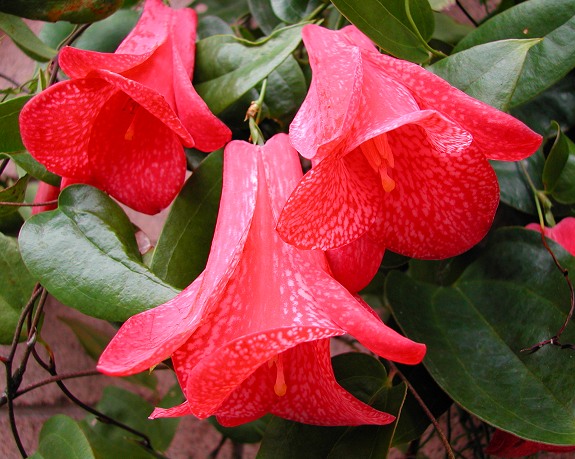| Home |
Strange Wonderful Things Rare and exotic plants |
 |
|---|
Chilean Bellflower
Soil -- Use a loose, well-draining soil mix. A typical mix is mix is 2 parts potting soil, 1 part perlite (small or medium) or coarse sand, and 1 part small bark pieces or chunky perlite. Don't add lime to the mix, since Lapageria likes acidic soil.
Watering -- Keep the soil evenly moist. Don't allow it to dry out, but avoid keeping it constantly soggy too.
If your tap water is very high in minerals ("hard" water), you might need to use bottled water or rain water.
Lighting -- Lapageria likes a few hours of direct sun, but it should be shaded from strong, hot sun.
Your plant was grown in filtered light and should be acclimated to sun slowly over 2-4 months, watching for possible burning.
Climate -- It prefers mild daytime temperatures and cool nights. It's happiest between about 40 and 85 degrees (5-29°C), and above freezing. Adult plants are reported to tolerate down to the low 20s (-5°C) if given overhead protection. But protect your seedlings from frost the first 3-4 years.
In warmer climates, keep the pot shaded so the roots stay cool. An easy way to do this is to place the pot inside a second pot made of clay, and fill any extra space with soil.
Over about 40% humidity is best. If it seems to suffer in low humidity indoors, consider using an ultrasonic room humidifier, sold at home improvement stores and some thrift shops.
Fertilizing -- Lapageria is slow-growing and doesn't need lots of fertilizer. Feed about every 3 months with an all-purpose fertilizer that contains micronutrients. nic fertilizer every 4-6 weeks, at 1/4 strength.
Transplanting -- Repot carefully to avoid disturbing the root mass. If your plant is in a 2½ inch pot, it may be transplanted to 5 inch pot or a tall 4 inch pot for 1-2 years, then to a 1-2 gallon (4-8 liter) container, which can hold it until it flowers. After another 2 years, you can move it to a 3-5 gallon (11-19 liter) container.
Support -- Adult plants prefer to twist around a trellis, fence, wires, etc. Smaller plants may not need support.
Flowering- When your plant nears flowering size, expose it to cool night temperatures in the fall and spring to encourage blooming. Aim for at least 8 hours a day below 59 degrees F (15°C) for 6 weeks, but keep it above 35 degrees F (2°C).
Pests to watch for -- Protect from snails and slugs, which love the leaves. Watch for any pests that affect your other plants.
If you have any questions, feel free to contact me.
Enjoy your plant!
- Jeff
Strange Wonderful Things
| Home |
Strange Wonderful Things Rare and exotic plants |
|
|---|---|---|
| Entire site Copyright 2003-2025 by Strange Wonderful Things, except as noted | ||

